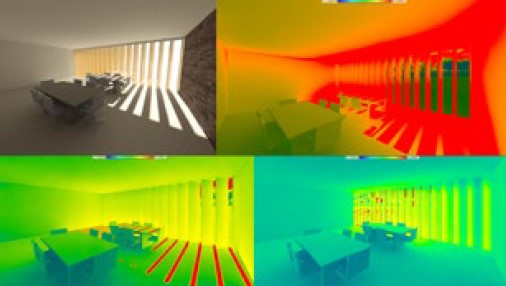Architectural technology research at Sheffield Hallam University
Contents |
[edit] Introduction
The Institute, as part of its accreditation procedures, recognises educational establishments as Centres of Excellence for demonstrating a robust research culture, which has a direct and significant impact to the discipline of Architectural Technology. Not only do educational establishments prepare future professionals, they are also responsible for some of the innovation which is being adopted by industry. The research institutes within our four Centres of Excellence are highlighted in AT Journal and we begin with Sheffield Hallam University.
At Sheffield Hallam University, Architectural Technology research is described by four main themes of inquiry:
- Practice and management
- Building performance and energy efficiency
- Construction and materials
- Digital technology
[edit] 1. Practice and management
The role of the architectural technologist in the 21st century is changing. The way by which architectural technologists adapt to new architectural service environments drives our research. The theme concerns methods and ways of conducting commercial architectural technology practice.
Our research looks into how architectural technologists could increase effectiveness and productivity in the industry. External factors of policy and regulation also shape our research. Broadly, we are interested in areas of construction management, business economics and professional practice.
[edit] 2. Building performance and energy efficiency
In a world facing climate change, to achieve environmental comfort, the scientific and measurable understanding of how buildings perform is important. This understanding improves how architectural technologists create sustainable buildings which are fit for purpose and are environmentally appropriate.
Our research is covered by two key areas: firstly, investigating indoor/outdoor environmental conditions including thermal analysis, daylight and artificial lighting, ventilation and air quality; secondly, developing sustainable building technologies, including passive, active and hybrid systems.
[edit] 3. Construction and materials
The notion of building correctly in the 21st century intrigues our research in the area of construction and materials. We invent new building methods and materials to solve past, present and future challenges facing our built environments.
As well as being provocative, futuristic and speculative, our researchers examine historic methods and materials developed over centuries to understand and apply ancient wisdom to construction problems today. Our specialism spans different materials, from stone, masonry, concrete, thin shells, lightweight construction and hybrid framed systems to timber materials such as CLT.
We are interested in construction method innovations and have developed expertise in concrete formwork - specifically fabric formwork. Our university has conducted material research and laboratory testing commissioned by private and government bodies such as English Heritage and BRE in the past.
[edit] 4. Digital technology
Our research focuses on the application of digital technologies for problem solving and/or allowing us to see and understand problems better. We research computational design using computer software such as Dynamo and Grasshopper. We conduct research in virtual reality (VR) specifically on digital LIDAR scanning and digital fabrication.
We are also developing research interests in information management and big data, as well as interactive environments using hardware (microcontrollers) and software (computer programing). Additionally, we have expertise in environmental analysis tools such as IES-VE (heating/cooling), CFD (ventilation) and radiance (daylighting/ lighting).
Architectural technology research at Sheffield Hallam University is often cross-disciplinary and aimed at being impactful and practical. Working at the cutting edge of technology, our research often informs our teaching practices.
|
Case study one Over the years, Sheffield Hallam University has developed an international reputation for combining technology research with life-scale construction of shells and lightweight structures. In 2016, to mark the Festival of Making in Sheffield, UK, a lightweight gridshell was designed and built. In collaboration with Swiss and Dutch engineers and architects based then at ETH Zurich, the 10m x 10m double-curved structure was constructed by students using glass-fibre reinforced polymer tubes. The structure was form-found and analysed digitally. This event coincided with the release of the Routledge book Timber Gridshells co-authored by Dr Gabriel Tang. A series of public lectures on the design and construction of related structures was organised. Accompanying this was an exhibition based on the book that charts the development and evolution of timber gridshells in the last five decades. This experimental construction builds on previous investigative workshops on the design and construction of lightweight structures made from bio-based materials such as pine timber and bamboo. In previous years, construction workshops involving the design and construction of lightweight structures had also been organised successfully:
Our research is driven by the need to use materials economically to produce sustainable technology solutions in a resource sensitive world. This blue-sky investigative research harnesses technical creativity within a specific time-frame. Further exploration in lightweight construction is being conducted at Sheffield Hallam University. Results of this research are disseminated at international conferences and technical papers in journal articles. Further reading:
|
|
Case study two The advancement in software and hardware technology offers new opportunities for architectural technologists to create responsive systems. This development has provided innovative solutions to improve shading systems and a new paradigm to respond effectively to environmental factors. Technological systems in buildings are diverse based on preferences to meet user comfort, energy efficiency and building standards. However, high tech systems are commonly perceived as a technological trend rather than architectural systems. Furthermore, most simple dynamic shading systems were assessed against energy demand, whilst the complex models were frequently evaluated based on daylight performance. On the other hand, assessments of thermal performance criteria are limited and occasionally considered, whilst energy generation, ventilation and view are rarely addressed. These technical and environmental aspects of system development present a challenge for architectural technologists. Cutting-edge research in the area of responsive architecture is being conducted at Sheffield Hallam University in collaboration with researchers in Malaysia to advance the system performance based on integrated design objectives in tropical and temperate climates. The research examines geometries, motions, mechanisms and control strategies of different dynamic models. The research distinguished two levels in responsive design: (i) macro-scale level, which focuses on the composition of units, elements and movements and (ii) micro-scale level, which focuses on the geometric shape, sizes and motion layout at the level of the shading unit. In addition, this research engages with essential aspects related to automation and control systems, which include sensors, actuators, controllers and software. This engagement considers it important to simplify controller technologies in architectural designs that resulted in distinguishing two paradigms, namely, responsive/reactive and interactive systems. The research is in the development stage and managed to establish a classification model and a systematic framework for designers. Finally, to gain more insight into the research, further details about research progress have been published in the journals of Automation in Construction and Solar Energy. Further reading:
|
This article originally appeared in the Architectural Technology Journal (at) issue 137 published by CIAT in spring 2021. It was written by Dr Gabriel Tang and Dr Karam M Al-Obaidi, Senior Lecturers in Architecture, Sheffield Hallam University.
--CIAT
[edit] Related articles on Designing Buildings
- Architectural Technology research at University of Derby.
- Architectural Technology research at Robert Gordon University.
- Architectural Technology research at Edinburgh Napier University.
- Architectural technologist.
- Architectural Technology research at Robert Gordon University.
- CIAT articles.
- Foldcore.
- Formwork.
- Shading coefficient for buildings.
- Sheffield Hallam University - Department of the Natural and Built Environment.
- The future of architectural education.
Featured articles and news
Infrastructure that connect the physical and digital domains.
Harnessing robotics and AI in challenging environments
The key to nuclear decommissioning and fusion engineering.
BSRIA announces Lisa Ashworth as new CEO
Tasked with furthering BSRIA’s impressive growth ambitions.
Public buildings get half a million energy efficiency boost
£557 million to switch to cleaner heating and save on energy.
CIOB launches pre-election manifesto
Outlining potential future policies for the next government.
Grenfell Tower Inquiry announcement
Phase 2 hearings come to a close and the final report due in September.
Progress from Parts L, F and O: A whitepaper, one year on.
A replicated study to understand the opinion of practitioners.
ECA announces new president 2024
Electrical engineer and business leader Stuart Smith.
A distinct type of countryside that should be celebrated.
Should Part O be extended to existing buildings?
EAC brands heatwave adaptation a missed opportunity.
Definition of Statutory in workplace and facilities management
Established by IWFM, BESA, CIBSE and BSRIA.
Tackling the transition from traditional heating systems
59% lack the necessary information and confidence to switch.
The general election and the construction industry
As PM, Rishi Sunak announces July 4 date for an election.
Eco apprenticeships continue help grow green workforce
A year after being recognised at the King's coronation.
Permitted development rights for agricultural buildings
The changes coming into effect as of May 21, 2024.

























